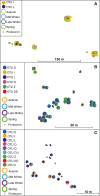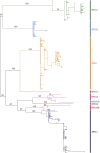Temporal turnover of Ceratobasidiaceae orchid mycorrhizal fungal communities with ontogenetic and phenological development in Prasophyllum (Orchidaceae)
- PMID: 38835172
- PMCID: PMC11687622
- DOI: 10.1093/aob/mcae089
Temporal turnover of Ceratobasidiaceae orchid mycorrhizal fungal communities with ontogenetic and phenological development in Prasophyllum (Orchidaceae)
Abstract
Background and aims: Plant-fungus symbioses may experience temporal turnover during the ontogenetic or phenological development of the host, which can influence the ecological requirements of the host plant. In this study, we investigate temporal turnover of Ceratobasidiaceae orchid mycorrhizal fungal (OMF) communities in Prasophyllum (Orchidaceae), asking whether OMF communities are subject to temporal change attributable to orchid phenology or ontogeny.
Methods: Roots of adult Prasophyllum frenchii, Prasophyllum lindleyanum and Prasophyllum sp. aff. validum from Australia were sampled between autumn and spring. Seed was sown in situ as 'baits' to explore the mycorrhizal associations of germinating protocorms, which were compared with OMF in roots of co-occurring adult plants. Culture-dependent and -independent sequencing methods were used to amplify the internal transcribed spacer and mitochondrial large subunit loci, with sequences assigned to operational taxonomic units (OTUs) in phylogenetic analyses. Germination trials were used to determine whether fungal OTUs were mycorrhizal.
Key results: A persistent core of OMF was associated with Prasophyllum, with Ceratobasidiaceae OMF dominant in all three species. Phenological turnover occurred in P. lindleyanum and P. sp. aff. validum, but not in P. frenchii, which displayed specificity to a single OTU. Ontogenetic turnover occurred in all species. However, phenological and ontogenetic turnover was typically driven by the presence or absence of infrequently detected OTUs in populations that otherwise displayed specificity to one or two dominant OTUs. Ex situ germination trials showed that 13 of 14 tested OTUs supported seed germination in their host orchid, including eight OTUs that were not found in protocorms in situ.
Conclusions: An understanding of OMF turnover can have practical importance for the conservation of threatened orchids and their mycorrhizal partners. However, frameworks for classifying OMF turnover should focus on OTUs important to the life cycle of the host plant, which we suggest are likely to be those that are frequently detected or functionally significant.
Keywords: Prasophyllum; Ceratobasidiaceae; Orchidaceae; conservation; fungi; mycorrhiza; ontogenetic; orchid; phenology; seed baiting; temporal turnover.
© The Author(s) 2024. Published by Oxford University Press on behalf of the Annals of Botany Company. All rights reserved. For commercial re-use, please contact reprints@oup.com for reprints and translation rights for reprints. All other permissions can be obtained through our RightsLink service via the Permissions link on the article page on our site—for further information please contact journals.permissions@oup.com.
Conflict of interest statement
The authors have no relevant financial or non-financial interests to disclose.
Figures






Comment in
-
How important is important? A commentary on 'Temporal turnover of Ceratobasidiaceae orchid mycorrhizal fungal communities with ontogenetic and phenological development in Prasophyllum (Orchidaceae)'.Ann Bot. 2024 Dec 31;134(6):i-ii. doi: 10.1093/aob/mcae142. Ann Bot. 2024. PMID: 39375015
Similar articles
-
High specificity of a rare terrestrial orchid toward a rare fungus within the North American tallgrass prairie.Fungal Biol. 2019 Dec;123(12):895-904. doi: 10.1016/j.funbio.2019.09.010. Epub 2019 Oct 4. Fungal Biol. 2019. PMID: 31733732
-
A leafless epiphytic orchid, Taeniophyllum glandulosum Blume (Orchidaceae), is specifically associated with the Ceratobasidiaceae family of basidiomycetous fungi.Mycorrhiza. 2019 Mar;29(2):159-166. doi: 10.1007/s00572-019-00881-7. Epub 2019 Feb 1. Mycorrhiza. 2019. PMID: 30707331
-
Continental-scale distribution and diversity of Ceratobasidium orchid mycorrhizal fungi in Australia.Ann Bot. 2021 Aug 26;128(3):329-343. doi: 10.1093/aob/mcab067. Ann Bot. 2021. PMID: 34077492 Free PMC article.
-
Mycorrhizal fungi affect orchid distribution and population dynamics.New Phytol. 2018 Sep;219(4):1207-1215. doi: 10.1111/nph.15223. Epub 2018 May 23. New Phytol. 2018. PMID: 29790578 Review.
-
Orchid Reintroduction Based on Seed Germination-Promoting Mycorrhizal Fungi Derived From Protocorms or Seedlings.Front Plant Sci. 2021 Jun 30;12:701152. doi: 10.3389/fpls.2021.701152. eCollection 2021. Front Plant Sci. 2021. PMID: 34276753 Free PMC article. Review.
Cited by
-
Core Mycorrhizal Fungi Promote Seedling Growth in Dendrobium officinale: An Important Medicinal Orchid.Plants (Basel). 2025 Mar 25;14(7):1024. doi: 10.3390/plants14071024. Plants (Basel). 2025. PMID: 40219092 Free PMC article.
-
Composition and Biodiversity of Culturable Endophytic Fungi in the Roots of Alpine Medicinal Plants in Xinjiang, China.J Fungi (Basel). 2025 Feb 3;11(2):113. doi: 10.3390/jof11020113. J Fungi (Basel). 2025. PMID: 39997407 Free PMC article.
-
How important is important? A commentary on 'Temporal turnover of Ceratobasidiaceae orchid mycorrhizal fungal communities with ontogenetic and phenological development in Prasophyllum (Orchidaceae)'.Ann Bot. 2024 Dec 31;134(6):i-ii. doi: 10.1093/aob/mcae142. Ann Bot. 2024. PMID: 39375015
References
-
- Anderson MJ, Crist TO, Chase JM, et al.2011. Navigating the multiple meanings of β diversity: a roadmap for the practicing ecologist. Ecology Letters 14: 19–28. - PubMed
-
- APNI. 2023. Australian Plant Name Index. https://biodiversity.org.au/nsl/services/search/names (14 August 2023, date last accessed).
-
- Batstone RT, Carscadden KA, Afkhami ME, Frederickson ME.. 2018. Using niche breadth theory to explain generalization in mutualisms. Ecology 99: 1039–1050. - PubMed
-
- Berendsen RL, Pieterse CM, Bakker PA.. 2012. The rhizosphere microbiome and plant health. Trends in Plant Science 17: 478–486. - PubMed
-
- Bidartondo MI, Read DJ.. 2008. Fungal specificity bottlenecks during orchid germination and development. Molecular Ecology 17: 3707–3716. - PubMed
MeSH terms
Grants and funding
LinkOut - more resources
Full Text Sources

